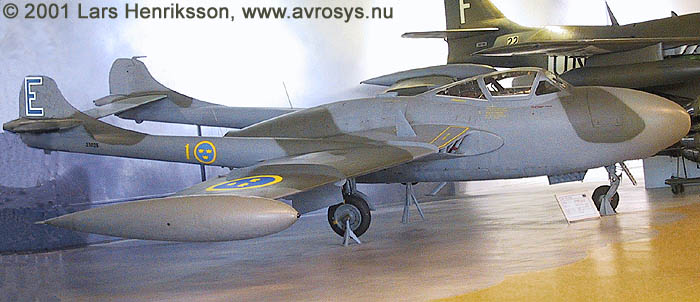|
|
||
| J 33 - De Havilland 112 NF.51 Venom (1953-1960) | ||
| Page 1 (1) | ||
|
|
||
 |
||
|
The first night fighters in the Air Force were 60 surplus de Havilland Mosquitoes (J 30) delivered in
1948-49. They became based at Wing F 1 in Västerås, a former
bomber wing. The Mosquito was a war product and the Swedish purchases
were stricken by a lot of accidents. 23 aircraft, 38 % of the total,
were lost beyond repair in crashes during five years, with the loss of
life for
16 aircrew. The tolerance of the authorities had reached the
end. Before the planned all-weather fighter J 32B could be taken in
service, a safer substitute to the J 30 Mosquito had to be provided.
The Air Force had
good experiences of the J 28 de Havilland Vampire fighter. A
contract of the delivery of the new design DH 112 NF.2 (Night Fighter Mk
2) Venom, a further development of the Vampire,
was signed with the British manufacturer. Fifty-nine aircraft
were delivered and flown home to F 1 in Sweden 1952-53.
The engines, de Havilland Ghost (RM 2A, 2.270 kp)
and the armaments, 20 mm Hispano automatic cannons (4 per aircraft) were
manufactured under license in Sweden and shipped to Britain. Due to modified radar- and radio equipment compared with the
RAF Venoms, de Havilland changed the designation NF.2 to NF.51. The Swedish designation became J 33.
The J 33 had to be modified from the beginning.
Problems when flying at high speeds had to be cured with modifications
of the fuselage. Disturbances due to poor surface treatment had to be
attended to. The Venom was not fitted with ejector seats and the cockpit
canopy was hard to open if
it became necessary to bail out. A new, hydraulic opened canopy was
designed. The radar equipment was also upgraded.
The Swedish Venoms were replaced by J 32B Lansen
during 1959-60. Four aircraft were kept as target-tugs, operated by
Svensk Flygtjänst.
The preserved J 33 on the photo is displayed at
Flygvapenmuseum at Linköping. C/n 12374, Sw AF/n 33025.
|
|
|
|
|
||
|
|
||
|
|
||
| © Lars Henriksson |
|
Updated 2010-02-13 |
|
Custom Search
|
||